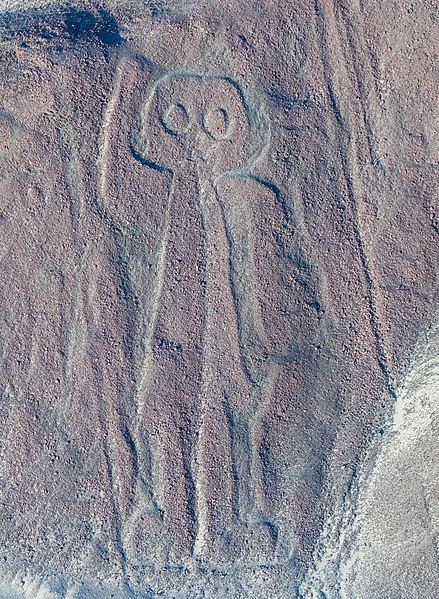The Enigmatic God Kon and the Nazca “Astronaut”: Unraveling Peru’s Desert Mystery

Credit: Diego Delso, delso.photo, License CC BY-SA
The article is also available as video for barrier-free access to information!
Nazca, Peru
High in the arid plateaus of southern Peru lies one of the world’s most mysterious archaeological marvels: the Nazca Lines. Etched into the desert over 1,500 years ago, these giant geoglyphs—depicting animals, plants, and geometric patterns—have long captivated scientists and the public alike. Among them, one figure stands out: a humanoid with large eyes, waving one hand. Dubbed the “Astronaut” by modern observers, this figure has drawn intense speculation. But could it actually represent an ancient deity—the mysterious god Kon?
According to ancient Andean mythology, Kon was one of the principal gods worshipped along Peru’s coastal regions. Revered as a creator god and bringer of rain, Kon was said to have come from the north and to have possessed the power to move through the skies. Some accounts describe him as a figure without bones, able to travel swiftly, bringing life and fertility to the parched lands of the coast before being exiled by more aggressive deities like Pachacamac.
In light of this mythology, some scholars and indigenous interpreters believe the so-called “astronaut” figure might actually represent Kon. With his raised hand and seemingly oversized eyes, the figure carved into the hillside above the Nazca plains could be a symbolic depiction of the sky-traveling god.
Dr. María Estévez, an anthropologist at the Universidad Nacional Mayor de San Marcos, elaborates:
“Kon is often overlooked in modern interpretations of Andean cosmology, yet he held immense significance for pre-Inca coastal civilizations. The figure known today as the ‘astronaut’ is most likely not a spaceman, but a godlike being—perhaps Kon—symbolizing control over the skies and the life-giving forces of weather and rain.”
The “astronaut” geoglyph, located on a steep slope and measuring roughly 30 meters tall, differs significantly from the flatter Nazca Lines below. Some experts argue that this location may have been chosen to make the figure more visible from far distances, aligning with the idea of a celestial or divine observer watching over the land.
However, not everyone agrees. The figure’s round eyes and disproportionate head have led some theorists—most notably proponents of ancient astronaut hypotheses—to argue that it represents an extraterrestrial visitor. This fringe theory was popularized in the 1960s by Erich von Däniken, who suggested that advanced alien beings helped shape early civilizations and left their mark in places like Nazca.
Still, mainstream archaeologists continue to stress a cultural and spiritual interpretation grounded in the beliefs of the Paracas and Nazca peoples. “It’s important to resist the temptation to project modern fantasies onto ancient art,” says Dr. Estévez. “We must respect the sophistication and symbolism of indigenous cultures, who had deep astronomical and spiritual knowledge long before the arrival of Europeans.”
Whether deity or alien, the figure known as the Nazca “astronaut” continues to inspire awe and debate. And as researchers work to better understand pre-Columbian mythology, figures like Kon may finally be restored to their rightful place in the stories etched into the Peruvian desert.
—
Did you know? The Nazca Lines were declared a UNESCO World Heritage Site in 1994, and aerial surveys continue to reveal new geoglyphs each year—suggesting there is still much more to discover beneath the desert sands.





